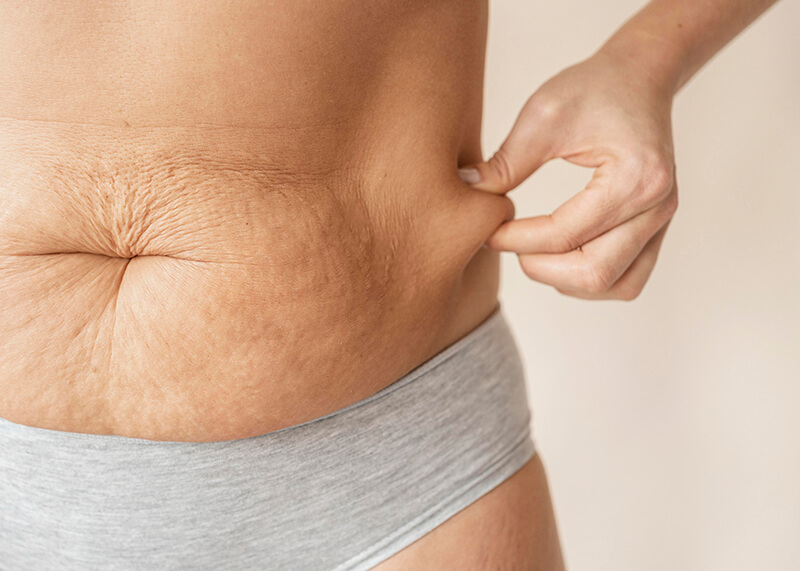After a tummy tuck (abdominoplasty), it’s common to experience swelling that fluctuates throughout the day, sometimes lasting weeks as your body heals. This fullness is a normal response to surgical tissue trauma and part of the natural recovery process. By understanding the expected stages of post-op swelling, you can better track your progress, recognize signs of normal healing, and identify any potential concerns early.
What Causes Swelling After a Tummy Tuck?
Surgery separates skin, fat, and muscle layers, interrupting tiny lymphatic channels that normally drain fluid. Inflammation rushes repair cells to the area, while gravity and the new pocket beneath the skin let serum collect, often called a seroma. Studies report seroma rates between 4 % and 38 % in the first month, highlighting how common fluid build-up is in abdominoplasty patients.
Factors that can intensify edema include:
- Higher BMI or large-volume liposuction performed at the same time
- Smoking or nicotine use (slows micro-circulation)
- History of abdominal surgery (scarred lymphatics)
- Poor garment compliance or early strenuous activity
Timeline & Stages of Swelling After Tummy Tuck
Post-tummy-tuck swelling follows a predictable pattern that unfolds over weeks and months. Knowing the typical milestones makes it easier to track normal healing and spot any concerns early.
| Stage | When You’ll Feel It | What You May See | Key Care Points |
| Immediate Post-Op | Days 1–3 | Tight, drum-like abdomen; drains in place | Strict rest, head-of-bed elevation, full-time compression |
| Early Recovery | Days 4–7 | Swelling peaks ~day 5, bruising appears | Short walks, maintain garment, hydration |
| Sub-Acute | Weeks 2–4 | Puffiness lowers toward pubic area; “board-hard” feel | Begin lymphatic massage, light chores |
| Intermediate | Weeks 5–12 | On–off end-of-day swelling; waistline refines in morning | Resume cardio/strength per surgeon |
| Maturation | Months 3–12 | Occasional mild bloating; scars flatten, contour finalizes | Core exercises, scar care, photos at 12 mo |
The fluid pathway continues to remodel for a full year, so small fluctuations are expected even after month 3.
Managing Swelling During Recovery
Postoperative edema follows expected healing processes, but its severity and duration can often be reduced with proper, evidence-based care. A well-planned recovery, developed with your board-certified plastic surgeon, addresses fluid retention, promotes lymphatic drainage, and helps prevent complications like seroma or blood clots. The strategies below are key to managing swelling after an abdominoplasty.
1. Compression Garments
Wear your surgical garment exactly as directed typically 23 hours a day for the first three weeks because consistent yet comfortable compression limits fluid build-up and supports the newly contoured tissues. A study published in 2022 suggests that while marginal differences exist among pressure gradients, proper fit and patient comfort have a greater impact on edema control than sheer tightness alone.
2. Early Ambulation
Begin gentle, short walks as soon as your surgeon allows, since the rhythmic contraction of your calf muscles acts as a natural pump that aids lymphatic drainage and reduces the risk of postoperative blood clots.
3. Nutrition & Hydration
Consume 60 to 80 grams of protein per day, keep total sodium below 2 grams, and drink adequate water so your body has the building blocks and fluid balance needed to repair tissue and flush excess extracellular fluid.
4. Manual Lymphatic Drainage (MLD)
Schedule sessions with a certified therapist once your drains have been removed; light, directional strokes combined with low-intensity therapeutic ultrasound have been shown in controlled trials to cut down edema and soften early scar tissue.
5. Kinesio or Gentle Taping
Applying elastic therapeutic tape in a fan pattern lifts the skin microscopically, enhancing micro-circulation and accelerating the resolution of bruising and swelling documented after body-contouring procedures.
6. Watch for Red Flags
Contact your surgeon immediately if you notice sudden one-sided swelling, heat, fever, calf pain, or shortness of breath, because these symptoms may indicate infection or the formation of a blood clot.
Consultation With a Board-Certified Plastic Surgeon
Only your surgeon can distinguish “routine” swelling from complications like seroma, hematoma, or deep-vein thrombosis (DVT). At NW Face & Body, patients seeking a tummy tuck in Bellevue benefit from double-board-certified surgeons use Vectra® 3-D imaging to set realistic expectations and an AAAHC-accredited OR to minimize risk. Scheduled follow-ups include ultrasound checks when necessary so fluid pockets can be aspirated early, preventing contour irregularities.
Book Your Consultation at NW Face & Body
NW Face & Body’s accredited Kirkland clinic offers private tummy-tuck evaluations that outline your best surgical options and recovery roadmap in one streamlined visit. Simply call 425-576-1700 or click here to request your slot. Our team will confirm the next available time and guide you through every step that follows.
Frequently Asked Questions
How long does post-tummy-tuck swelling last?
Most of the visible swelling resolves by weeks 6–12, but subtle “water weight” shifts can continue up to 12 months as lymphatics mature.
What can I do to reduce swelling during recovery?
During recovery, walk several times daily, stay hydrated, keep sodium low, and consider professional MLD to keep the swelling in check.
Can swelling affect my tummy-tuck results?
If the edema is constant, it can mask final contour and stretch scars. Unmanaged seromas may harden (pseudobursa) and distort shape, so early evaluation is important.
Are there any risks of blood clots after a tummy tuck?
Yes, abdominoplasty carries one of the highest venous-thromboembolism rates in cosmetic surgery; risk climbs with BMI > 30, smoking, or combined procedures. However, early movement and surgeon-directed prophylaxiscan help lower that risk.
What should I do if swelling persists after the recommended recovery period?
If the swelling continues, schedule a follow-up exam. Your surgeon may order an ultrasound to rule out fluid pockets, DVT, or lymphedema and will adjust compression or consider aspiration.






